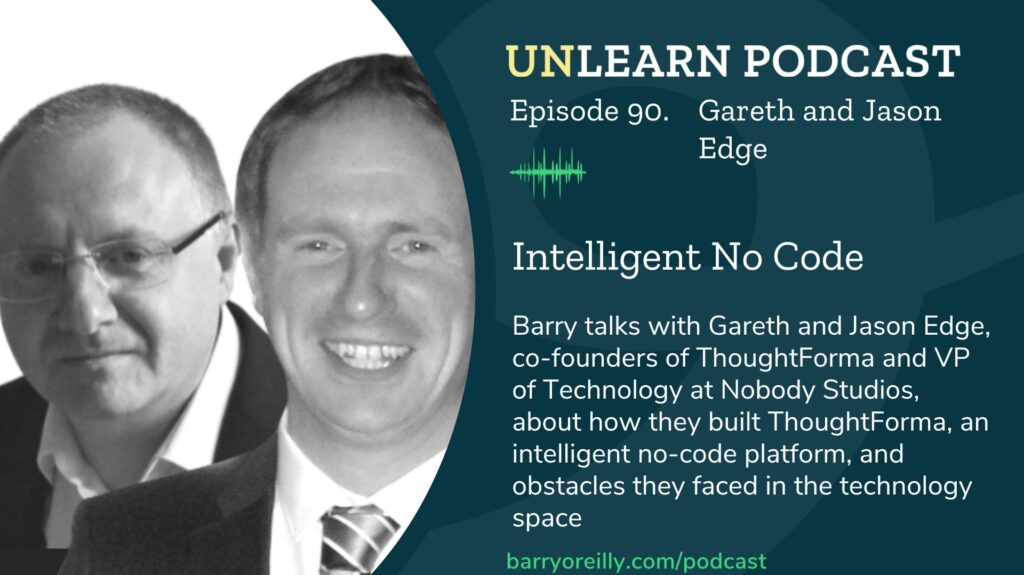Jason and Gareth Edge are co-founders of ThoughtForma, the intelligent no-code platform with a mission to help people unlock and realize their purposeful ideas. As CTO and CEO respectively, they aim to break the barriers to entry that technology itself often represents, and obliterate the obstacles to creativity and enterprise in the digital space. Both brothers are VPs of Technology at Nobody Studios. In this episode of Unlearn, Jason and Gareth share their story with Barry O’Reilly, discussing how they built their company and obstacles they faced in the technology space.
How It Started
Gareth shares the inspiration behind ThoughtForma. Building software is a hard thing to do and people – both individuals and organizations – often struggle during the process. Even with a team of skilled technologists with great track records, it’s still difficult to deliver robust solutions. Coupled with a shortage of technical skills, this leads to many projects never seeing the light of day. “That’s [what] puts a fire in my belly,” Gareth says, “this notion of ideas staying locked in people’s heads is completely unacceptable to me.” He was inspired to make a difference after attending Web Summit Lisbon 2017. “I thought if I could make technology easier to use, then maybe people who aren’t technologists that have great ideas could start bringing them to life and make a real impact in the world.” [Listen from 1:50]

A Pleasant Coincidence
Gareth pitched the idea to his brother Jason, who happened to be working on something related. “I was able to dovetail into his vision and we came up with the ideal, no-code platform, which is our answer to the Al Gore problem,” Jason explains. He approached building the platform via an unconventional route, as he had been working for a consultancy specializing in the implementation of Master Data Management Systems. He was hitting some walls in implementing these systems. Jason started thinking about how he could capture the data he wanted without having to rebuild and redesign, and how he could put such a tool in the hands of consultants so they wouldn’t have to rely on people to build things for them. “It turns out that the ideas I came up with were so flexible that you can actually apply them to describe and manage anything, even all the ingredients of a web or mobile application. That realization became the underpinnings of where we are today,” he shares. [Listen from 5:30]
(Listen to “Red Team Thinking and Finding Opportunities in Chaos with Bryce Hoffman“)
Startup Land
It doesn’t matter how good you think your product is – you won’t escape Startup Land, Gareth advises. “I feel fortunate that I was so naive from the start,” he tells Barry. “I fell into the trap of the field of dreams. ‘If we build it, the users are going to come. Why wouldn’t they?’ That was the first unlearning for me.” They faced many hurdles in building the platform and the company. Scarcity of capital was one issue, as was the realization that they were lacking many skills. “How important marketing is, how important financial planning, how to build companies, how to build startups – it [was] all a massive learning curve.” [Listen from 10:25]
Gareth advises listeners to find a good advisor, coach or mentor in the early days, someone who has been through it all, because you “just can’t do it alone.” The things they learned from Barry after meeting him put structure around the chaos, he adds. [Listen from 12:25]
No-code, Serverless Technology
Business is so often about competition, Barry says, so it’s enjoyable to see how the companies in Nobody Studios are helping each other. “What we’re seeing is people genuinely helping one another and growing together. That’s really fascinating to hear you both talk about that.” Jason describes how they got around technical debt. In the software space, technical debt refers to an issue in development where you gradually create a problem you’ll later have to solve. Jason got around that by using templates to write the system, rather than manually rewriting everything. This way, if he wanted to make significant changes in architectural approach, he could just change the templates and regenerate the system. [Listen from 17:20]
Serverless technology is a misnomer, Jason shares, because it implies that your back end has no server. Nothing could be further from the truth – there is an enormous wealth of servers that power serverless technology. What makes it different is that with serverless, developers don’t have to know about any of the behind-the-scenes operations. You can just use the technology for the seconds that you need it, and you’re charged on that basis alone. [Listen from 22:20]
(Listen to “Standing Ovationz with Ray Leonard Jr“)
Looking Ahead
Jason and Gareth are launching a new pattern matching and recognition feature in the near future. “[This] is a key point in our growth story because that now… allows [our users] to self-service so that if they hit upon a feature that ThoughtForma doesn’t currently support codelessly, they can build it themselves, and then share that back into the community.” [Listen from 33:05]
Don’t miss an episode! Subscribe to our newsletter.















